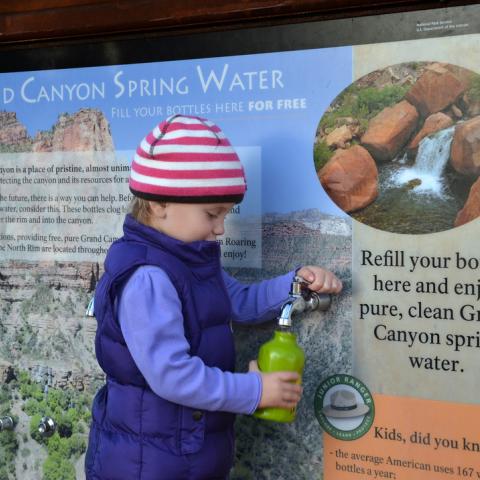
Water conservation measures have been reinstituted for the South Rim of Grand Canyon National Park/NPS
Just 24 hours after lifting water conservation measures for the South Rim of Grand Canyon National Park, a pipeline break has put the measures back in place.
A park release Tuesday evening said the water conservation measures were necessitated by a pipeline break along the North Kaibab Trail. Conservation measures had been lifted Monday following problems with a pump at Havasupai Gardens that took more than a week to fix.
The reinstituted water conservation measures require all park residents and visitors to conserve and reduce water usage wherever possible in homes, hotel rooms, and campgrounds.
Mandatory water conservation measures include:
- No watering lawns/plants
- No washing cars, boats, bikes, or any outside vehicle
- Utilize dry precleaning methods to scrape off food items before thoroughly washing dishes.
- Fill the sink with water while washing dishes to avoid running water
- Take shorter or less frequent showers
- Turn water off while you shave or brush your teeth
- Use low water cleaning techniques and reduce toilet flushing to the minimum necessary
- Report drips, leaks, or other water loss to appropriate offices
- Remove outside hoses from spigots when not in use
Conservation measures require that all concessions operations:
- Alter menus to use less water for food prep and dish washing
- Adopt low water use for hotel room cleaning
- Serve drinking water at restaurants by request only
Hikers in the backcountry should plan to carry all their water or methods to treat water. For the most updated information on water availability in the backcountry visit the park’s Critical Backcountry Updates web page.
The frequent water woes are related to the park's antiquated Transcanyon Pipeline. Work on rebuilding the aged pipeline began last year.
Rebuilding the waterline, at a projected cost of $208 million, involves upgrades to the associated water delivery system within the inner canyon and South Rim. This critical investment will ensure the park is able to meet water supply needs for the next 50 plus years, supporting 6 million annual visitors and approximately 2,500 year-round residents, accoriding to a park release.
The Park Service is replacing the pipeline because it is beyond its expected useful life, experiences frequent failures, and requires expensive and continuous inner canyon maintenance work to repair leaks. Since 2010, there have been more than 85 major breaks in the pipeline that have disrupted water delivery. Costs for a single isolated break often exceed $25,000. Conditions in the inner canyon include extreme terrain and high temperatures, which increase risk to employees during repair operations. The system also supplies water for fire suppression for all South Rim and inner canyon facilities, including more than 800 buildings listed in the National Register of Historic Places.
Originally built in the 1960s, the pipeline is a 12 ½-mile waterline that provides the potable water for all facilities on the South Rim and inner canyon facilities within the park. The rehabilitation project will move the water intake for the system from Roaring Springs to Bright Angel Creek near Phantom Ranch. This location will greatly reduce the length of the pipeline and eliminate a portion of the current waterline north of Phantom Ranch that experiences the most frequent failures. The water intake at Roaring Springs will continue to provide water to the North Rim.




 Support Essential Coverage of Essential Places
Support Essential Coverage of Essential Places






